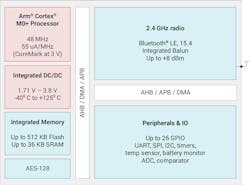MCUs Will Bring More Bluetooth to More Places
Members can download this article in PDF format.
Check out the other 2023 IDEA Award Nominees.
Since the arrival of IoT, the growth of network connectivity has been unprecedented. How does one wrap their arms around a market for Bluetooth devices that’s escalating so rapidly?
But don’t take our word for it. The Bluetooth Special Interest Group estimates that annual shipments of Bluetooth-enabled devices will exceed 7 billion in 2026, which is nearly 2 billion more than in 2022. Of these, Bluetooth Low Energy (LE), the power-conserving variant of Bluetooth personal area network (PAN) technology, will continue to have a decisive impact—95% of all Bluetooth devices will include BLE by 2026, representing a 25% compound annual growth rate (CAGR).
By way of review, Bluetooth LE is a short-range connectivity technology that enables wireless personal area networks (PANs) using radio waves in the 2.4 GHz band, while consuming a minimal amount of energy to connect devices.
In this article we will examine how TI’s affordable wireless MCUs can enable engineers to add Bluetooth LE in even more products going forward. But first a bit of background.
Bluetooth was invented in 1998 by the Bluetooth Special Interest Group and since has changed how information transmission works in a PAN. The high amount of energy required to maintain a long-lasting Bluetooth connection created the need for developing Bluetooth LE. It accomplishes the primary purpose of Bluetooth technology while maintaining low power consumption.
Affordable Wireless MCUs for Bluetooth LE
About a year ago, Texas Instruments announced its next-generation Bluetooth LE devices. The CC2340, for example, delivers low-power, high-quality RF with best-in-class standby current—less than 830 nA (see figure). The reduction in standby current helps extend battery life for up to 10 years on a coin-cell battery in wireless applications such as electronic shelf labels and tire-pressure monitoring systems.
The CC2340 family also features an operating temperature range of –40 to 125°C to help ensure a stable connection across applications from industrial sensors and medical laboratories to outdoor environments such as electric-vehicle (EV) chargers or smart meters. Best of all, pricing for the SimpleLink Bluetooth LE CC2340 family starts as low as $0.79, making it more affordable for engineers to add Bluetooth LE connectivity.
With the proliferation of Bluetooth LE applications, designers need additional memory capacity to easily update software remotely. The CC2340R2 and CC2340R5 wireless MCUs offer flash memory of 256 kB and 512 kB, respectively, thus providing exceptional flexibility for engineers and ample space for application code.
In addition, engineers can expand RF performance and connection range with output power of up to +8 dBm, the industry's highest among competing Bluetooth LE wireless MCUs, according to TI. In addition, the CC2340 devices feature an integrated RF balun to enable a simpler design with fewer external components, leading to cost savings.
This latest wireless MCU family further features 36 kB of RAM with over-the-air download support. With best-in-class standby current and RF performance, its aim is to enable more Bluetooth in more places at half the price of competing devices.
Connect in 2 Minutes or Less
TI created the new SimpleLink CC2340 wireless MCU family with the goal of being the easiest-to-use Bluetooth LE devices on the market. With the SimpleLink CC2340 LaunchPad development kit, available for $39, you can quickly establish a Bluetooth LE connection in two minutes or less.
In fact, connecting your Bluetooth LE is so easy that a kid can do it. As proof we filmed a video showing that a child can get a Bluetooth LE connection up and running with our devices in under four minutes.
Unrivaled Support
Bluetooth LE devices have become more capable, smaller, and more cost-effective. As a result, designers are considering using Bluetooth technology where they never have before.
To help out, TI is applying its 20+ years of connectivity experience to develop high-quality, cost-effective low-power Bluetooth LE wireless MCUs, certified modules, and transceivers, along with complete software offerings to fit any RF design need. Targeted applications range from automotive to personal electronics.
Discover the Possibilities
In 2023, TI plans to continue to expand this new device family into a variety of product offerings.
TI’s low-cost Bluetooth LE or dual-mode Bluetooth devices support the full spectrum of new Bluetooth standards such as high-speed, long-range, Bluetooth Mesh, direction finding, multiprotocol support and more. With the best-in-class standby current and RF performance at half the price of competing devices Bluetooth LE can bring new and expanded levels of connectivity.
So, whether you’re working on a simple design or building a complex system, you can partner with TI for any wireless design needs.

